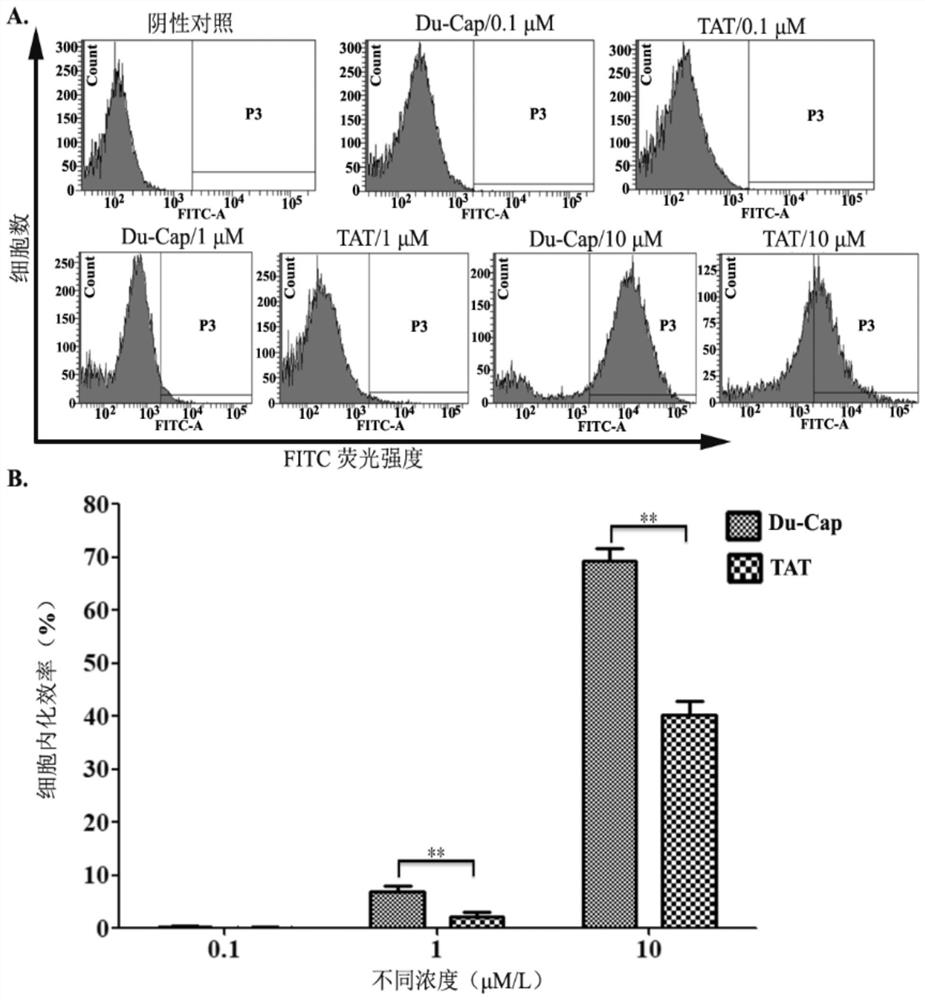A kind of cell-penetrating peptide derived from cap protein of duck circovirus and its design method and application
A membrane-penetrating peptide and cell technology, applied in the field of cell-penetrating peptides, can solve the problems of weakening immune stimulation effect and prolonging residence time
- Summary
- Abstract
- Description
- Claims
- Application Information
AI Technical Summary
Problems solved by technology
Method used
Image
Examples
Embodiment 1
[0037] Example 1 Bioinformatics analysis and synthesis of candidate cell-penetrating peptides of duck circovirus Capsid aa 18-37
[0038] Use the online server Multalin (http: / / www.sacs.ucsf.edu / cgi-bin / multalin.py) to compare and analyze the Capsid of different duck circovirus reference strains in GenBank, such as figure 1 Its N-terminal sequence (aa18-37) is shown to be highly conserved and rich in positively charged arginine (R), marked with a black border.
[0039] Use the online server PEP-FOLD 3 ( https: / / bioserv.rpbs.univ -paris-diderot.
[0040] fr / services / PEP-FOLD3 / ) to simulate the three-dimensional structure of its N-terminal sequence (aa 18-37), such as figure 1 It was found that it has a similar α-helical structure characteristic to the commonly used cell-penetrating peptide TAT.
[0041] specific, figure 1 Middle: A: N-terminal sequence comparison of Capsid of different duck circovirus reference strains; Consensus: Consensus of different sequence alignments...
Embodiment 2
[0045] Example 2 Laser Confocal Microscopy Detection of Du-Cap aa18-37's Cell Transmembrane Function and Characteristics
[0046] (1) Place sterile cell slides in a 12-well cell culture plate, and place 5×10 5 Hela cells, HD11 cells and 3D4 / 21 cells were seeded into cell culture plates.
[0047] (2) After overnight culture, take the synthetic short peptide (Du-Cap aa 18-37) and dilute it to 5 μM, mix it with 500 μL serum-free medium and add it to the cell wells. Use TAT as a positive control and FITC dye as a negative control . Place the cell mixture at 37°C, 5% CO 2 Incubate in an incubator for 20 min. After incubation, wash with 1mL of PBS each time, a total of 3 times, to remove short peptides that did not enter the cells.
[0048] (3) Stain with Hoechst 33342, a nuclear marker dye, for 5 minutes, and wash with PBS.
[0049] (4) The cell slides were taken out, placed upside down on a glass slide, sealed with transparent nail polish, and scanned and photographed under d...
Embodiment 3
[0051] Example 3 Flow cytometry detection of different concentrations of Du-Cap aa18-37 and TAT transmembrane efficiency comparison
[0052] (1) Divide 5×10 5 Hela cells were seeded into 12-well plates and washed once with PBS after overnight culture.
[0053] (2) Short peptides of different concentrations (0.1 μM / L, 1 μM / L and 10 μM / L) and 500 μL Opti-MEM medium were added to the cells, and no short peptide was used as a negative control, 37 ° C, 5% CO 2 , under the condition of incubation for 20min.
[0054] (3) Wash with PBS 3 times, 1 min each time. Add 200 μL trypsin and 100 μL PBS and mix well to digest the cells for 3 minutes. Add fresh cell culture medium containing serum to terminate the digestion, collect the cell suspension in a 1.5mL centrifuge tube, and centrifuge at 400×g for 2min.
[0055] (4) Discard the supernatant. Add 1mL PBS, wash once; repeat wash once; add 400μL PBS to resuspend the cells, mix thoroughly, filter each tube of cells into the flow tube...
PUM
 Login to View More
Login to View More Abstract
Description
Claims
Application Information
 Login to View More
Login to View More - R&D
- Intellectual Property
- Life Sciences
- Materials
- Tech Scout
- Unparalleled Data Quality
- Higher Quality Content
- 60% Fewer Hallucinations
Browse by: Latest US Patents, China's latest patents, Technical Efficacy Thesaurus, Application Domain, Technology Topic, Popular Technical Reports.
© 2025 PatSnap. All rights reserved.Legal|Privacy policy|Modern Slavery Act Transparency Statement|Sitemap|About US| Contact US: help@patsnap.com



